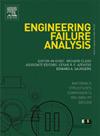增材制造Ti-6Al-4V的拉伸和疲劳行为:表面织构和去除的影响
IF 5.7
2区 工程技术
Q1 ENGINEERING, MECHANICAL
引用次数: 0
摘要
研究了四种不同的表面材料去除处理对激光粉末床熔接Ti-6Al-4V试样拉伸和疲劳行为的影响。这些处理包括直接抛光、浅加工和抛光、深加工和深加工和抛光。使用x射线计算机断层扫描对每种情况下的表面织构和体积缺陷进行表征,并使用扫描电子显微镜对所有失效样品进行断口分析。结果表明,材料去除方式对拉伸延展性和抗疲劳性能有较大影响。由于残余表面谷,直接抛光不能提高拉伸延展性和疲劳寿命。由于充分去除了表面异常,浅加工和抛光的组合试样的延展性得到了显著改善,但由于表面连接的体积缺陷的持续存在,疲劳寿命只得到了适度的提高。然而,深度加工和深度加工与抛光相结合的处理导致了延展性和抗疲劳性的显著提高,这是由于完全消除了表面和表面下的缺陷。此外,使用疲劳缺口因子方法对疲劳寿命进行建模和估计,该方法对未经处理、抛光和浅加工和抛光的试样进行了相当准确的预测。本文章由计算机程序翻译,如有差异,请以英文原文为准。

Tensile and fatigue behaviors of additively manufactured Ti-6Al-4V: Influence of surface texture and removal
This study examined the influence of four different surface material removal treatments on the tensile and fatigue behaviors of laser powder bed fused Ti-6Al-4V specimens. These treatments included direct polished, shallow machined and polished, deep machined, and deep machined and polished. X-ray computed tomography was used to characterize the surface textures and volumetric defects of each condition, and scanning electron microscopy was used for fractography of all failed specimens. The results showed that tensile ductility and fatigue resistance were strongly influenced by the type of material removal methods. Direct polishing did not improve the tensile ductility nor fatigue lives due to remnant surface valleys. While the combined shallow machined and polished specimens exhibited significant improvement in ductility due to adequate removal of surface anomalies, fatigue lives were only modestly enhanced due to the persistence of surface-connected volumetric defects. However, deep machined and combined deep machined and polished treatments led to considerable improvement in both ductility and fatigue resistance, which was ascribed to complete removal of surface and subsurface defects. In addition, fatigue life was modeled and estimated using a fatigue notch factor approach, which yielded reasonably accurate predictions for the untreated, polished, and shallow machined and polished specimens.
求助全文
通过发布文献求助,成功后即可免费获取论文全文。
去求助
来源期刊

Engineering Failure Analysis
工程技术-材料科学:表征与测试
CiteScore
7.70
自引率
20.00%
发文量
956
审稿时长
47 days
期刊介绍:
Engineering Failure Analysis publishes research papers describing the analysis of engineering failures and related studies.
Papers relating to the structure, properties and behaviour of engineering materials are encouraged, particularly those which also involve the detailed application of materials parameters to problems in engineering structures, components and design. In addition to the area of materials engineering, the interacting fields of mechanical, manufacturing, aeronautical, civil, chemical, corrosion and design engineering are considered relevant. Activity should be directed at analysing engineering failures and carrying out research to help reduce the incidences of failures and to extend the operating horizons of engineering materials.
Emphasis is placed on the mechanical properties of materials and their behaviour when influenced by structure, process and environment. Metallic, polymeric, ceramic and natural materials are all included and the application of these materials to real engineering situations should be emphasised. The use of a case-study based approach is also encouraged.
Engineering Failure Analysis provides essential reference material and critical feedback into the design process thereby contributing to the prevention of engineering failures in the future. All submissions will be subject to peer review from leading experts in the field.
 求助内容:
求助内容: 应助结果提醒方式:
应助结果提醒方式:


